The first Long-term Insights Briefing explores how the APS could integrate artificial intelligence (AI) into public service delivery in the future, and how this might affect the trustworthiness of public service delivery. This background paper summarises the results of two complementary surveys used to capture community sentiment: a quantitative survey administered to a representative sample of the Australian population, and an online ‘Have You Say’ survey to hear from people in their own words. The surveys provide an insight into the community’s expectations, concerns, and views on possible benefits from the public service’s use of AI.
The Long-term Insights Briefings
On 13 October 2022, the Minister for the Public Service, the Hon Katy Gallagher, announced that the APS would commence Long-term Insights Briefings as a part of the Government’s APS Reform Agenda.
The Long-term Insights Briefings are an initiative under Priority Two of the APS Reform Agenda: An APS that puts people and business at the centre of policy and services. They will strengthen policy development and planning in the APS by:
- Bringing together and helping the APS to understand the evidence, context, trends and implications of long-term, strategic policy challenges.
- Building the capability and institutional knowledge of the APS for long-term thinking, and position the APS to support the public interest now and into the future, by understanding the long-term impacts of what the APS does.
The purpose of the briefings is not to make recommendations or predictions about what will happen in the future. Instead, they will provide a base to underpin future policy thinking and decision making on specific policy challenges that may affect Australia and the Australian community in the medium and long term. It is anticipated they will form part of the evidence base for policy and decision making.
The briefings will use stakeholder engagement, research and futures thinking to analyse significant, complex, longer-term and cross-cutting issues. Importantly, the briefings will be developed through a process of genuine engagement with the Australian community on issues affecting them, as well as with experts from the APS, academia, industry and the not-for-profit sector.
This background paper summarises the results of surveys undertaken for the first Long-term Insights Briefing, on ‘How might artificial intelligence affect the trustworthiness of public service delivery’.
Back to topThe first Long-term Insights Briefing
The first Long-term Insights Briefing explored how the APS could integrate AI into public service delivery in the future, and how this might affect the trustworthiness of public service delivery. AI could potentially transform public service delivery in ways that deliver a better experience and outcomes for the whole community. However, implementing AI poorly – such as by failing to address known risks of the technology, or failing to understand and respond to the concerns of different cohorts in the community – could erode the trustworthiness of the public service. This could result in the APS and the community as a whole failing to capture the benefits of AI.
The briefing used community engagement and research, together with futures thinking and expert engagement to explore how AI could transform public service delivery and the potential impacts of these changes on trustworthiness of service delivery agencies (Figure 1).
Figure 1. Phases and activities in the Long-term Insights Briefing pilot
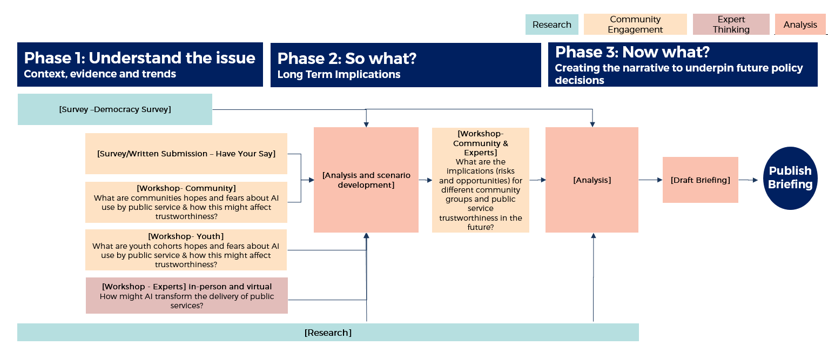
Why use surveys in the Long-term Insights Briefing pilot?
Surveys were used to capture community sentiment and provide insights into the community’s expectations, concerns, and views on possible benefits from the public service’s use of AI. Importantly, the surveys filled a gap in knowledge of community sentiment. While there is information available on trust in public services,1 and trust in AI and other emerging technologies, less is known about trust in government’s use of AI in public service delivery. Surveys in the Long-term Insights Briefing pilot were a means to better understand the community’s views on the use of AI in the delivery of public services, and the factors that affect the trustworthiness of government agencies.
Two complementary survey instruments were used for this purpose:
Survey of Trust in Australian Democracy: Three close-ended questions were included as part of a larger, online “Survey of Trust in Australian Democracy” conducted by the Australian Public Service Commission. These questions sought to:
- measure current levels of trust in the public service’s use of AI
- deepen understanding of factors that moderate the community’s acceptance of AI’s use for public service delivery, including: how and/or where AI is used in service delivery; and demographic, socio-economic and contextual factors.
The survey was administered by Painted Dog Research via an online panel to ensure a robust, representative sample.
- Have Your Say survey: To hear from people in their own words, an online “Have Your Say” public consultation was conducted. The survey invited community members to share their views on what made a service trustworthy to them and what their hopes and fears were with regards to the use of AI in public service delivery were. People were provided with the option to complete a short survey or submit a written submission. The survey was hosted on the APS Reform website and included a mix of open-ended and option-based questions, complementing the questions posed in the Survey of Trust in Australian Democracy and guided by the same broad research questions.
The responses to both surveys were analysed in combination with demographic factors including age, gender and location, in order to understand differences in sentiment across community cohorts. The Survey of Trust in Australian Democracy and Have Your Say survey are in Appendix A.
Back to topWho did we hear from?
Survey of Trust in Australian Democracy
A sample of 5039 responses was collected, aiming for representation across gender, age and location. The sample was then post weighted to be representative of the Australian population by age and gender (interlocking) and state. The demographic split of responses was as follows:
- Gender: 48% Male; 51% Female
- Age: 29% aged 18-34; 34% aged 35-54; and 37% aged 55+
- Location: 68% metro residents; and 32% regional residents
- State: 32% NSW; 26% VIC; 20% QLD; 10% WA; 7% SA; 2% ACT; 2% TAS; 1% NT
Have Your Say
We received 135 responses to the Have Your Say public consultation – 133 survey responses and 2 written submissions. This was a self-selection survey, meaning that people choose to complete it, and as such is not representative of the Australian population. Most people shared demographic details with us, with only 11 people choosing to not share these details. Responses were received from 74 women, 49 men and one non-binary person. An equal number of responses was received from people under 45 and over 45; 62 responses for each of these categories. Three quarters of people were based in capital cities. Eight people indicated that they identify as a person with disability.
Back to topSurvey Findings
Survey of Trust in Australian Democracy
People were asked to note their responses to three questions.
Question 1 : To what extent do you …
- Feel you know about AI
- Think you understand when AI is being used
Options [Not at all - Slightly – Moderately well – Very well - Completely]
When asked about their knowledge of AI and understanding of AI applications, more than half of people (57%) reported having zero or slight knowledge of AI. Almost two thirds (63%) reporting having zero or slight understanding of when AI is being used.
Figure 2. Knowledge of AI and understanding of when its being used
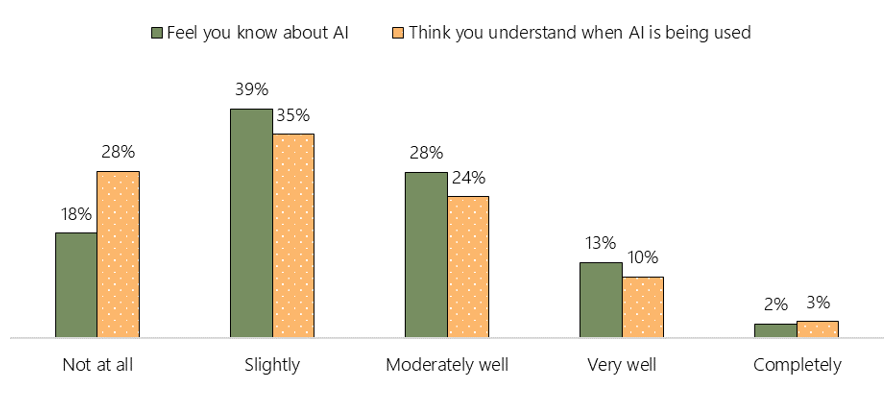
Source: Australian Public Service Commission, Survey of Trust in Australian Democracy (forthcoming)
Question 2: How much do you trust government agencies to responsibly use AI for the following purposes?
- Delivering better quality services
- Faster processes or service delivery times
- Creating financial efficiencies or savings
- Giving personalised customer advice and service
- Allowing future innovations (e.g. new services)
Options [Strongly distrust - Distrust - Neither trust or distrust – Trust - Strongly trust- Not sure]
When asked about their current level of trust in government to responsibly use AI, the responses varied by the purpose for which AI is used (Figure 3).
- 42% of people said they trust government agencies to responsibly use AI to deliver services faster.
- More people distrust government to responsibly use AI to provide personalised services (34%) than trust government (29%).
- Only one in 3 consider ‘providing personalised services’ as very important.
- More than one in 3 reported that they neither trust nor distrust government to responsibly use AI or were unsure.
Figure 3. Trust in government to responsibly use AI in public service delivery varies by the purpose for which AI is being used
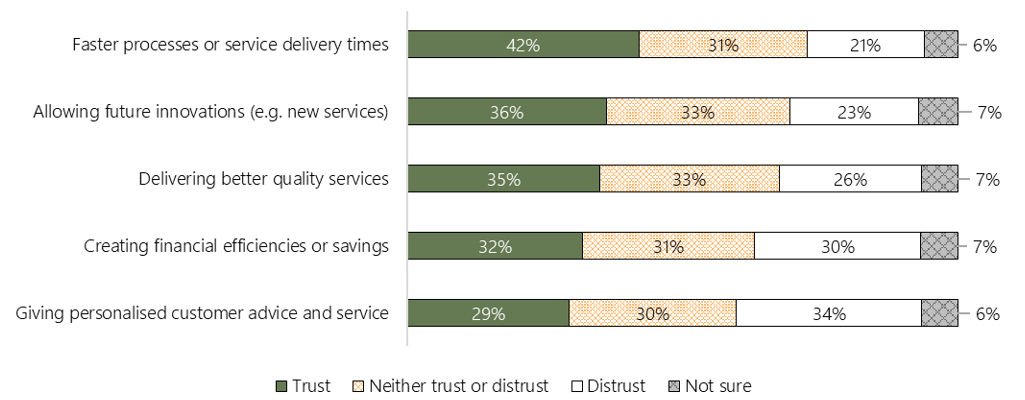
Notes: Trust results show percentage of people who said they ‘trust’ or ‘strongly trust’ government agencies to responsibly use AI for the outlined purpose; Distrust results show percentage of people who said they ‘distrust’ or ‘strongly distrust’ government agencies to responsibly use AI for the outlined purposes.
Source: Australian Public Service Commission, Survey of Trust in Australian Democracy (forthcoming)
Question 3: Thinking about how much you trust or distrust government agencies to responsibly use AI, how important are each of these factors to you?
- Having regulations and laws in place to protect the community
- Providing services that are tailored to individuals
- Showing clear benefits to society (e.g. improving people’s lives)
- Demonstrating increased efficiency and cost savings
- Protecting personal information
- Keeping humans in control of decisions
- Being transparent about how and where AI is used
- Demonstrating the safety of AI systems
- Increasing your own knowledge of AI
- Ensuring AI systems treat different groups fairly
Options [Not important at all - Somewhat important - Important - Very important – Not sure]
When asked about factors that are important for trusting government to responsibly use AI, all options were selected as important by at least 80% of people (Figure 4). However, there were notable differences in the factors that were considered to be “very important”. Three in 4 people consider protecting personal information as ‘very important, and around 2 in 3 indicate transparency in how/when AI is used and laws/regulations protecting community is also ‘very important’. Providing personalised services ranked lowest, with only one in 3 people considering it ‘very important’.
Figure 4. Importance of factors in trusting government agencies to responsibly use AI
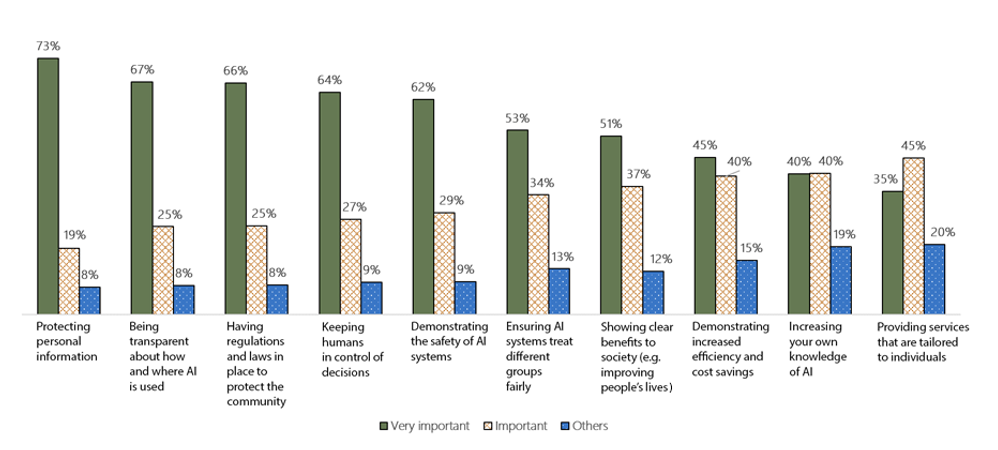
Notes: Results show importance given to each of the listed factors in trusting government agencies to responsibly use AI. Others include results for people who selected “Somewhat important”, “Not important at all” and “Not sure”.
Source: Australian Public Service Commission, Survey of Trust in Australian Democracy (forthcoming)
People with higher knowledge of AI have higher trust in government to responsibly use AI for the range of purposes. For example, 70% of people who reported knowing ‘very well’ about AI trust government to responsibly use AI to deliver faster services, compared with 54% who reported a moderate knowledge of AI, 37% who reported having a slight knowledge of AI, and 12% of people with no knowledge of AI (Figure 5).
Figure 5. Higher knowledge of AI is associated with higher trust in government to responsibly use AI in public service delivery
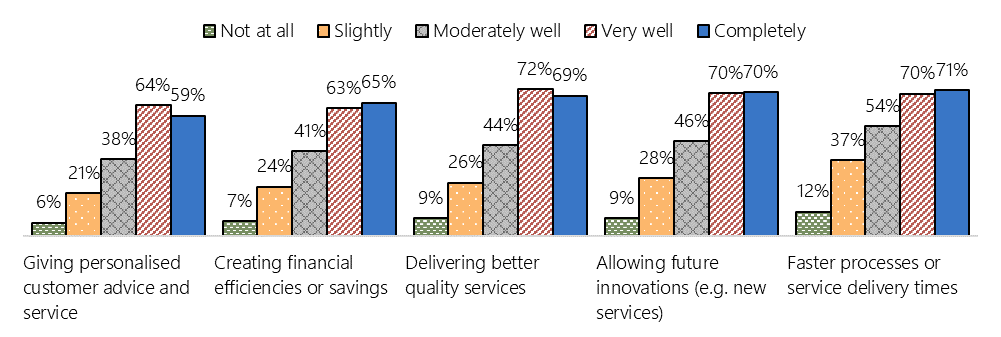
Notes: Results show percentage of people who said that they ‘trust’ or ‘strongly trust’ government agencies to responsibly use AI for the outlined purpose. Results are cut by people’ self-reported knowledge of AI from the options ‘Not at all’, ‘Slightly’, ‘Moderately well’, ‘Very well’, and ‘Completely’.
Source: Australian Public Service Commission, Survey of Trust in Australian Democracy (forthcoming)
Trust in government to responsibly use AI varies by demographic factors, with younger people (under 45) and culturally and linguistically diverse people reporting significantly higher trust and women, people in regional areas and unemployed people reporting lower trust than the total population.
- Younger people reported higher trust in government use of AI compared to older people (Figure 6).
- Women reported lower trust in government’s use of AI than men (Figure 7).
- People in regional Australia reported lower trust in government’s use of AI than those in metro areas (Figure 8).
- People born in Australia reported lower trust in government’s use of AI than those born overseas (with the exception of those born in the United Kingdom). People who speak English at home reported lower trust in government’s use of AI than those who speak a language other than English at home (Figure 9 and Figure 10).
Figure 6. Young people reported higher trust in government to responsibly use AI in public service delivery

Notes: Results show percentage of people who said that they ‘trust’ or ‘strongly trust’ government agencies to responsibly use AI for the outlined purpose, cut by age.
Source: Australian Public Service Commission, Survey of Trust in Australian Democracy (forthcoming)
Figure 7. Women reported lower trust in government to responsibly use AI in public service delivery

Notes: Results show percentage of people who said that they ‘trust’ or ‘strongly trust’ government agencies to responsibly use AI for the outlined purpose, cut by gender.
Source: Australian Public Service Commission, Survey of Trust in Australian Democracy (forthcoming)
Figure 8. People in regional Australia reported lower trust in government to responsibly use AI in public service delivery

Notes: Results show percentage of people who said that they ‘trust’ or ‘strongly trust’ government agencies to responsibly use AI for the outlined purpose, cut by region.
Source: Australian Public Service Commission, Survey of Trust in Australian Democracy (forthcoming)
Figure 9. People born in Australia reported lower trust in government to responsibly use AI in public service delivery
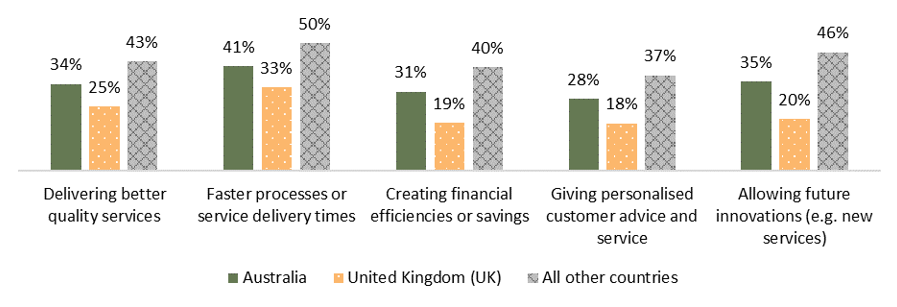
Notes: Results show percentage of people who said that they ‘trust’ or ‘strongly trust’ government agencies to responsibly use AI for the outlined purpose, cut by country of birth.
Source: Australian Public Service Commission, Survey of Trust in Australian Democracy (forthcoming)
Figure 10. People who speak a language other than English at home reported higher trust in government to responsibly use AI in public service delivery

Notes: Results show percentage of people who said that they ‘trust’ or ‘strongly trust’ government agencies to responsibly use AI for the outlined purpose, cut by language spoken at home.
Source: Australian Public Service Commission, Survey of Trust in Australian Democracy (forthcoming)
Have Your Say
People shared ‘in their own words’ what was important to them for building trust in public services through the Have Your Say survey. Some common themes were:
- Performance of the service: Ability of the APS to meet user needs and deliver efficient, timely, good quality and reliable services and ensure staff delivering the service are competent.
- Acting in the best interests of Australians: Functioning for social good, with an intention to act in good faith and for the benefit of Australian public; a public service that cares about the people it serves, shows an understanding of their needs and motivations, and is not out to get them.
- Responsible use of individuals’ data: Maintain data privacy and use information for the purpose for which it is collected.
- Integrity of the system; Ensure transparency in decision making and intent.
People also indicated that it was important that the services being accessed are truthful, fair, impartial, without bias, accountable and responsible. People said it was important to them that the service did what they said and kept their service delivery promises. People also indicated that users being included in service design process and ensuring human oversight for important decisions was important in them trusting the service being provided.
People saw many benefits of using AI in public services, mainly around improving how quickly and efficiently public services are provided. Other benefits mentioned by people includes cost savings, personalisation, optimising resource allocation and increased accuracy and productivity. People suggested care needs to be taken in where AI was used, especially when it came to:
- Decisions impacting individuals requiring empathy, compassion and emotional sensitivity.
- Areas like welfare, justice, immigration and health services.
- Services involving vulnerable groups.
- Agencies dealing with welfare or health.
- Public policy.
Some people suggested that AI use be limited until guardrails like governance and ethics frameworks are established and risks are properly understood and mitigation strategies and controls are in place. Some people suggested that the APS would need to increase its knowledge of AI and capacity to protect personal data. People indicated they would like the face-to-face model for client services to be retained, as some services always need human interaction. People also suggested a need for human oversight when AI is used, as they felt some services will always need human intervention.
Over half of the people indicated they have some understanding of AI and a third indicated they were well-informed about AI and its applications (Figure 11). This is expected in a self-selected survey as people interested in AI (and knowledgeable about AI) are likely to choose to complete the survey.
Figure 11. Knowledge of AI and understanding of when its being used
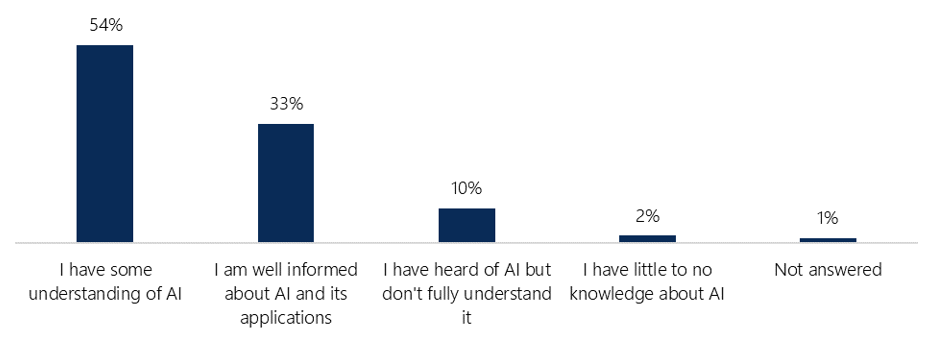
Source: Results of the Have Your Say consultation on How might artificial intelligence affect the trustworthiness of public service delivery?
News is the most popular AI learning source (Figure 12). People who are well-informed indicated they learnt about AI from ‘academic/technical research’ and ‘professional experience’. People who have some understanding of AI indicated their learning came from ‘news’, ‘research’ and ‘friends/family’. People who have little knowledge/understanding looked to ‘news’ and ‘social media’ for their knowledge.
Figure 12. How do people learn about AI
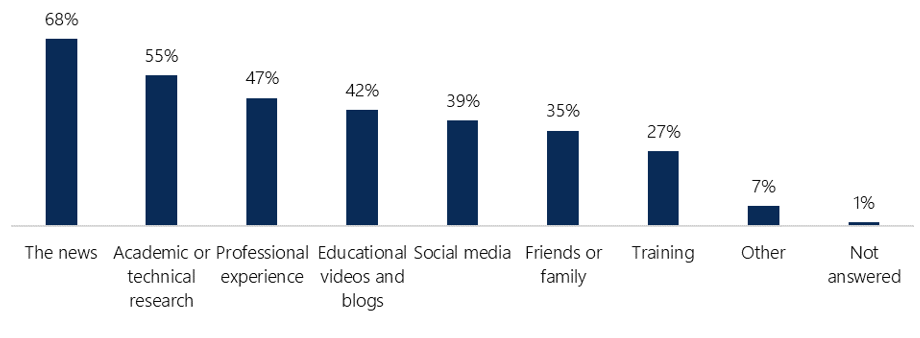
Source: Results of the Have Your Say consultation on How might artificial intelligence affect the trustworthiness of public service delivery?
People expressed multiple emotions in thinking about the impact of AI on society (Figure 13).
Figure 13. Feelings about the impact of AI on society
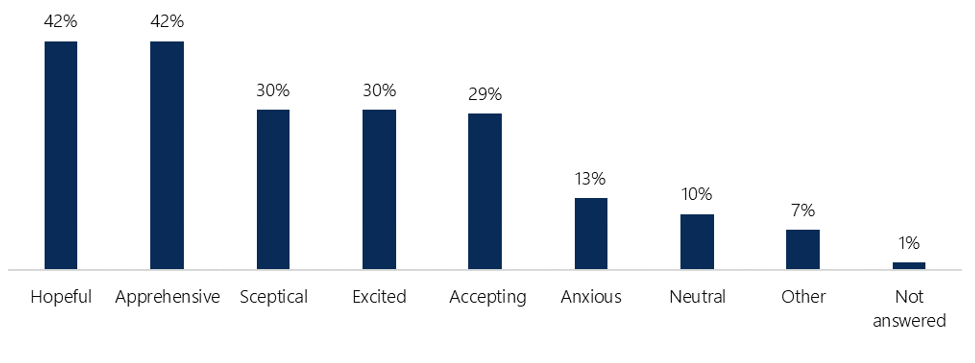
Source: Results of the Have Your Say consultation on How might artificial intelligence affect the trustworthiness of public service delivery?
Universities and research institutions are most trusted to responsibly use AI, with 3 in 5 people indicating that they trust them to do so. This is followed by Australian government, with one in 2 indicating trust. Businesses were trusted to responsibly use AI by 13% of respondents.
Figure 14. Entities trusted to responsibly use AI

Source: Results of the Have Your Say consultation on How might artificial intelligence affect the trustworthiness of public service delivery?
Respondents were also asked how important the following factors are in deciding whether they could trust how AI is being used, considering the use of AI in the delivery of public services:
- Services are better quality
- Services are tailored to individuals
- Future innovations are supported (e.g. providing new services)
- Regulations about AI are in place
- Personal information is protected
- Government is transparent about how and where AI is used
- Humans have higher level of control in final decisions
- Benefits to society are clear (e.g. improving people’s lives)
- AI systems treat different groups fairly
‘Protection of personal information’ and ‘Having AI regulations in place’ were the most important, with 9 in 10 rating them as ‘very important’. Eight in 10 respondents indicated that ‘transparency about how and where AI is used’ and ‘AI systems treating different groups fairly’ are ‘very important’. On the other hand, less than half of respondents indicated that ‘innovation is supported’ was ‘very important’.
Figure 15. Importance of factors in trusting government agencies to use AI

Notes: Results show importance given to each of the listed factors in trusting government agencies to use AI. Others include results for people who selected “Somewhat important”, “Not important at all” and “Not sure”.
Source: Results of the Have Your Say consultation on How might artificial intelligence affect the trustworthiness of public service delivery?
Respondents were asked how much they trust government agencies to do the following well, considering the use of AI in the delivery of public services:
- Improve service quality
- Tailor services to individuals
- Deliver services fasterSupport innovation
- Ensure regulations about AI are in place
- Protect personal information
- Be transparent about how and where AI is used
- Ensure humans have higher level of control in final decisions
- Benefits to society are clear (e.g. improving people’s lives)
- Ensure systems treat different groups fairly
One in 2 trust government agencies to deliver services faster and ensure regulations about AI are in place. Over 2 in 5 trust government agencies to protect personal information. Trust is lowest in the ability to ensure systems treat different groups fairly. Highest distrust was seen in service agencies ability to ensure that different groups are treated fairly. One in three also distrust that government agencies will be transparent about how and where AI is used, and ensure humans have higher level of control in final decisions.
Figure 16. People trust government agencies to do some things better than others when using AI in public service delivery
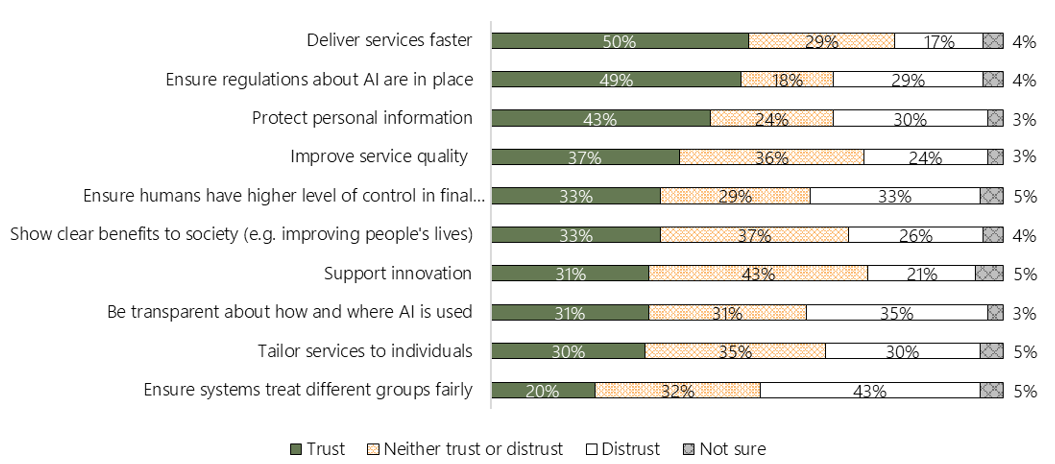
Notes: Trust results show percentage of people who said they ‘trust’ or ‘strongly trust’ government agencies to use AI well for the outlined purpose; Distrust results show percentage of people who said they ‘distrust’ or ‘strongly distrust’ government agencies to use AI for the outlined purpose.
Source: Results of the Have Your Say consultation on How might artificial intelligence affect the trustworthiness of public service delivery?
Back to topAppendix A: What did we ask people?
Survey of Trust in Australian Democracy
People were asked to note their responses to three questions as part of a larger “Survey of Trust in Australian Democracy”.
"We now have some questions about your views on use of artificial intelligence (AI) by government agencies.
Q30. To what extent do you ...
[Not at all - Slightly – Moderately well – Very well - Completely]
- Feel you know about AI
Think you understand when AI is being used
Q31. How much do you trust government agencies to responsibly use AI for the following purposes?
[Strongly distrust - Distrust - Neither trust or distrust – Trust - Strongly trust- Not sure]
- Delivering better quality services
- Faster processes or service delivery times
- Creating financial efficiencies or savings
- Giving personalised customer advice and service
- Allowing future innovations (e.g. new services)
Q32. Thinking about how much you trust or distrust government agencies to responsibly use AI, how important are each of these factors to you?
[Not important at all - Somewhat important - Important - Very important – Not sure]
- Having regulations and laws in place to protect the community
- Providing services that are tailored to individuals
- Showing clear benefits to society (e.g. improving people’s lives)
- Demonstrating increased efficiency and cost savings
- Protecting personal information
- Keeping humans in control of decisions
- Being transparent about how and where AI is used
- Demonstrating the safety of AI systems
- Increasing your own knowledge of AI
- Ensuring AI systems treat different groups fairly
Have Your Say survey
People were asked to note their responses to below questions, this included a mix of open-ended and option based questions. People were also provided with the option to submit a written submission instead of filling the survey.
- What does “trust” mean to you when you think about public services?
- What has the biggest impact on how much you trust or distrust public services?
- Which of the following best describes your understanding of AI?
- I have little to no knowledge about AI
- I have heard of AI but don’t fully understand it
- I have some understanding of AI
- I am well informed about AI and its applications
- Not sure
- From which of these sources have you learned about AI? [Select all that apply]
- Friends or family
- The news
- Social media
- Academic or technical research
- Training
- Professional experience
- Other _______
- Thinking about the impact of Artificial Intelligence on our society, which word best describes how you feel? [Select all that apply]
- Anxious
- Apprehensive
- Sceptical
- Neutral
- Accepting
- Hopeful
- Excited
- Other _______
- Which of the following would you trust most, to responsibly use AI? [Select all that apply]
- Australian Government
- State/territory governments
- Local governments
- Businesses
- Non-profit organisations
- Universities and research institutions
- None of these
- Other _______
- Considering the use of AI in the delivery of public services, what potential benefits would you expect to see?
- What concerns would you have, if any, considering the use of AI in the delivery of public services?
- Are there any specific public services which you believe should not use AI? If so, why?
- Considering the use of AI in the delivery of public services, how important are these factors in deciding whether you could trust how AI is being used?
[Not important at all - Somewhat important - Important - Very important – Not sure]- Services are better quality
- Services are tailored to individuals
- Future innovations are supported (e.g. providing new services)
- Regulations about AI are in place
- Personal information is protected
- Government is transparent about how and where AI is used
- Humans have higher level of control in final decisions
- Benefits to society are clear (e.g. improving people’s lives)
- AI systems treat different groups fairly
- Considering the use of AI in the delivery of public services, how much do you trust government agencies to do the following well?
[Strongly distrust - Distrust - Neither trust or distrust – Trust - Strongly trust- Not sure]- Improve service quality
- Tailor services to individuals
- Deliver services faster
- Support innovation
- Ensure regulations about AI are in place
- Protect personal information
- Be transparent about how and where AI is used
- Ensure humans have higher level of control in final decisions
- Benefits to society are clear (e.g. improving people’s lives)
- Ensure systems treat different groups fairly
- For example, see Department of the Prime Minister and Cabinet (2022), Trust in Australian public services: Annual Report 2022, Trust in Australian public services: 2022 Annual Report | PM&C (pmc.gov.au); OECD (2022), Building Trust to Reinforce Democracy: Main Findings from the 2021 OECD Survey on Drivers of Trust in Public Institutions, Building Trust in Public Institutions, OECD Publishing, Paris, https://doi.org/10.1787/b407f99c-en.Return to endnote 1 ↩
